Honda CBR1000RR
 | |
| Manufacturer | Honda |
|---|---|
| Also called | Fireblade |
| Production | Since 2004 |
| Predecessor | Honda CBR954RR |
| Class | Sport bike[1] |
| Related | Honda CBR600RR |
The CBR1000RR, known in some countries as the Fireblade, is a 999 cc (61.0 cu in) liquid-cooled inline four-cylinder sport bike, part of the CBR series that was introduced by Honda in 2004 as the seventh-generation of the series of motorcycles that began with the CBR900RR in 1992.
History
Racing roots
The Honda CBR1000RR was developed by the same team that was behind the MotoGP series.[2] Many of the new technologies introduced in the Honda CBR600RR, a direct descendant of the RC211V, were used in the new CBR1000RR such as a lengthy swingarm, Unit Pro-Link rear suspension, and Dual Stage Fuel Injection System (DSFI).
2004–2005
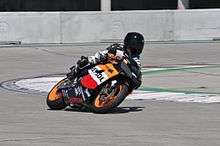
The seventh-generation RR, the Honda CBR1000RR, was the successor to the 2002-03 CBR954RR. While evolving the CBR954RR design, few parts were carried over to the CBR1000RR.[3] The compact 998 cc (60.9 cu in) in-line four was a new design, with different bore and stroke dimensions, race-inspired cassette-type six-speed gearbox, all-new ECU-controlled ram-air system, dual-stage fuel injection, and center-up exhaust with a new computer-controlled butterfly valve. The chassis was likewise all-new, including an organic-style aluminum frame composed of Gravity Die-Cast main sections and Fine Die-Cast steering head structure, inverted fork, Unit Pro-Link rear suspension, radial-mounted front brakes, and a centrally located fuel tank hidden under a faux cover. Additionally, the Honda Electronic Steering Damper (HESD) debuted as an industry first system which aimed to improve stability and help eliminate head shake while automatically adjusting for high and low speed steering effort.
A longer swingarm acted as a longer lever arm in the rear suspension for superior traction under acceleration and more progressive suspension action. Longer than the corresponding unit on the CBR954RR (585 mm (23.0 in) compared to 551 mm (21.7 in)) the CBR1000RR's 34 mm (1.3 in) longer swingarm made up 41.6 percent of its total wheelbase. The CBR1000RR's wheelbase also increased, measuring 1,405 mm (55.3 in); a 5 mm (0.20 in) increase over the 954.
Accommodating the longer swingarm was another reason the CBR1000RR power plant shared nothing with the 954. Shortening the engine compared to the 954 meant rejecting the conventional in-line layout. Instead, engineers positioned the CBR1000RR's crankshaft, main shaft and countershaft in a triangulated configuration, with the countershaft located below the main shaft, dramatically shortening the engine front to back, and moving the swingarm pivot closer to the crankshaft. This configuration was first successfully introduced by Yamaha with the YZF-R1 model in 1998 and inspired superbike design in the following years.
Positioning this compact engine farther forward in the chassis also increased front-end weight bias, an effective method of making high-powered liter bikes less wheelie prone under hard acceleration. This approach, however, also provided very little space between the engine and front wheel for a large radiator. Engineers solved this problem by giving the RR a modest cylinder incline of 28 degrees, and moving the oil filter from its frontal placement on the 954 to the right side of the 1000RR engine. This allowed the RR's center-up exhaust system to tuck closely to the engine.
2006–2007
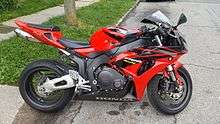
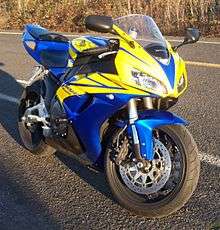
The eighth generation RR was introduced in 2006 and offered incremental advancements over the earlier model with more power, better handling and less weight. Changes for 2006 included:
- New intake and exhaust porting (higher flow, reduced chamber volume)
- Higher compression ratio (from 11.9:1 to 12.2:1)
- Revised cam timing
- More intake valve lift (from 8.9 mm to 9.1 mm)
- Double springs for the intake valves
- Higher redline (from 11,650 rpm to 12,200 rpm)
- Larger rear sprocket (from 41 to 42 teeth)
- New exhaust system
- New chassis geometry
- Larger 320 mm (13 in) front brake discs but thinner at 4.5 mm (0.18 in)
- Revised front suspension
- Revised rear suspension with new linkage ratios
- New lighter swingarm
- Revised front fairing design
The 2006 model carried over to the 2007 model year mostly unchanged except for color options.
2008 redesign
An all-new ninth-generation RR, the CBR1000RR was introduced at the Paris International Motorcycle Show on September 28, 2007 for the 2008 model year. The CBR1000RR was powered by an all-new 999 cc (61.0 cu in) inline-four engine with a redline of 13,000 rpm. It had titanium valves and an enlarged bore with a corresponding reduced stroke. The engine had a completely new cylinder block, head configuration, and crankcase with lighter pistons. A new ECU had two separate revised maps sending the fuel and air mixture to be squeezed tight by the 12.3:1 compression ratio. Ram air was fed to an enlarged air box through two revised front scoops located under the headlamps. Honda claimed power output to be at least 115 kW (154 hp) at 12,000 rpm.
Honda made a very focused effort to reduce and centralize overall weight. A lighter, narrower die-cast frame was formed using a new technique which Honda claimed allowed for very thin wall construction and only four castings to be welded together. Almost every part of the new bike was reengineered to reduce weight, including the sidestand, front brake hoses, brake rotors, battery, and wheels.
In order to improve stability under deceleration, a slipper clutch was added, with a center-cam-assist mechanism. The Honda Electronic Steering Damper was revised as well. Another significant change was the exhaust system, which was no longer a center-up underseat design. The new exhaust was a side-slung design in order to increase mass centralization and compactness while mimicking a MotoGP-style.
2009
On September 5, 2008, Honda announced the tenth generation of the RR as a 2009 model. The bike remained much the same, in terms of engine, styling, and performance. The only significant addition was the introduction of the optional factory fitted Combined ABS (C-ABS) system originally showcased on the CBR600RR Combined ABS prototype. New, lightweight turn signals were also added.
2010
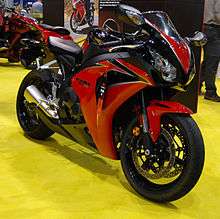
On September 4, 2009, Honda announced the eleventh generation of the RR as a 2010 model. Honda increased the diameter of the flywheel for more inertia. This improved low-rpm torque and smoother running just off idle. The license plate assembly was redesigned for quicker removal when preparing the motorcycle for track use. The muffler cover was also redesigned for improved appearance.
2012
The twelfth-generation Fireblade celebrated its 20th anniversary, revised for 2012, featuring Showa's Big Piston suspension technology, further improved software for the combined-ABS System, new 12-spoke wheels, aerodynamic tweaks, an all LCD display and other minor updates.[4]
2014
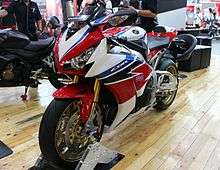
Retuned engine for additional power, modified rider position along with new windscreen. Also added a performance oriented "SP" variant.
2017
For 2017 with the 25th anniversary of the Fireblade Honda has updated their flagship CBR. With new features such as throttle-by-wire that works with selectable ride modes, new bodywork. Some of the new features on the SP model are revised frame and fuel tank made of Titanium and a 13:1 compression ratio. A retuned engine which now produces a claimed 189 hp (141 kW), a 10 hp increase and a 14kg (33lbs) weight reduction. Also adding a even more exotic limited production "SP2" variant with Marchesini forged wheels and with larger valves of which (500 units) will be sold.[5] [6][7]
Awards
The CBR1000RR was awarded Cycle World's International Bike of the Year for 2008-09 by the world's moto-journal communities as well as journalists.[8] The 2009 CBR1000RR won the Best Sportbike of the Year Award in Motorcycle USA Best of 2009 Awards,[9] having also won the over 750 cc open sportbike class in 2008.[10] The 2012 CBR1000RR won another Cycle World shootout,[11] as well as a Motorcycle USA best street[12] and track[13] comparisons.
Various teams have won the Suzuka 8 Hours endurance race nine times between 2004 and 2014.
Specifications
All specifications are manufacturer claimed.
| 2004-2005[14] | 2006-2007[15][16] | 2008-2011[17][18][19][20] | 2012 - [21] | |
|---|---|---|---|---|
| Engine | 998 cc (60.9 cu in) liquid-cooled inline four-cylinder | 999 cc (61.0 cu in) liquid-cooled inline four-cylinder | ||
| Bore × stroke | 75.0 mm × 56.5 mm (2.95 in × 2.22 in) | 76 mm × 55.1 mm (2.99 in × 2.17 in) | ||
| Compression ratio | 11.9:1 | 12.2:1 | 12.3:1 | |
| Valvetrain | Four valves per cylinder (DOHC) | |||
| Fuel | Dual Stage Fuel Injection (DSFI) | |||
| Ignition | Computer-controlled digital transistorized with 3D mapping | |||
| Power | 128.3 kW (172.0 bhp) @ 11,000 rpm[22] | 128.3 kW (172.0 bhp) @ 11,250 rpm[23] | 127.5 kW (171.0 hp) @ 10,670 rpm[24] | |
| Power rear wheel | 101.5 kW (136.1 hp)[1] | 106.3 kW (142.6 hp)[1] | 112.5 kW (150.9 hp)[1] | |
| Torque | 103.6 N·m (76.4 lbf·ft) @ 8,500 rpm[22] | 104.05 N·m (76.74 lb·ft) @ 8500 rpm[23] | 102.6 N·m (75.7 lbf·ft) (rear wheel)[1] | 106.2 N·m (78.3 lb·ft) @ 9,630 rpm[24] |
| Torque rear wheel | 96.8 N·m (71.4 lbf·ft)[1] | 99.4 N·m (73.3 lbf·ft)[1] | 102.6 N·m (75.7 lbf·ft)[1] | |
| Top Speed | 177 mph (285 km/h)[1] | 177 mph (285 km/h)[1] | 178 mph (286 km/h)[1] | |
| Drivetrain | Cassette-type, close-ratio six-speed, #530 O-ring sealed chain | Close-ratio six-speed, #530 O-ring sealed chain | ||
| Front suspension | 43 mm (1.7 in) inverted HMAS cartridge fork with spring-preload, rebound and compression-damping adjustability; 120 mm (4.7 in) travel | 43 mm (1.7 in) inverted Big Piston Fork with spring preload, rebound and compression damping adjustability | ||
| Rear suspension | HMAS Pro-Link single shock with spring-preload, rebound and compression-damping adjustability; 130 mm (5.3 in) travel | Unit Pro-Link HMAS single shock with spring pre-load, rebound and compression damping adjustability; 140 mm (5.4 in) travel | Unit Pro-Link Balance-Free Rear Shock with spring pre-load, rebound and compression damping adjustability | |
| Brakes | Front: Dual full-floating 310 mm (12 in) discs with four-piston radial-mounted callipers Rear: Single 220 mm (8.7 in) disc with single-piston calliper |
Front: Dual full-floating 320 mm (13 in) discs with four-piston radial-mounted callipers Rear: Single 220 mm (8.7 in) disc with single-piston calliper | ||
| Tires | Front: 120/70ZR-17 radial Rear: 190/50ZR-17 radial | |||
| Rake, trail | 23.75°, 102 mm (4.0 in) | 23.45°, 100 mm (3.9 in) | 23.3°, 96.2 mm (3.79 in) | 23.3°, 96.0 mm (3.78 in) |
| Wheelbase | 1,410 mm (55.6 in) | 1,400 mm (55.2 in) | 1,410 mm (55.4 in) | 1,410 mm (55.5 in) |
| Seat height | 830 mm (32.5 in) | 820 mm (32.3 in) | ||
| Dry weight | 195 kg (431 lb)[22] | 193 kg (425 lb)[23] | 175 kg (385 lb) | |
| Wet weight | 208–210 kg (459–463 lb)[1][22] | 204 kg (449 lb)[1] | 200 kg (440 lb)[1] | 205 kg (452 lb)[24] |
| Fuel capacity | 4.8 US gal (18 l; 4.0 imp gal), including 1.06 US gal (4.0 l; 0.88 imp gal) reserve | 4.7 US gal (18 l; 3.9 imp gal), including 1.06 US gal (4.0 l; 0.88 imp gal) reserve | ||
| Performance | ||||
| 0 to 60 mph (0 to 97 km/h) | 2.7–3.19 sec.[1][22] | 2.9–3.00 sec.[1][23] | 2.95 sec.[1] | 2.6 sec.[24] |
| 0 to 1⁄4 mi (0.00 to 0.40 km) | 10.14 sec. @ 226.58 km/h (140.79 mph)[22] | 9.98 sec. @ 230.8 km/h (143.4 mph)[22] | 9.94 sec. @ 230.33 km/h (143.12 mph)[1] | 9.82 sec. @ 232.98 km/h (144.77 mph)[24] |
| Top speed | 285–286 km/h (177–178 mph)[1][22] | 283–285 km/h (176–177 mph)[1][23] | 286 km/h (178 mph)[1] | 280 km/h (174 mph)[24] |
| Braking 60 to 0 mph (97 to 0 km/h) | 35 m (114 ft)[1] | 36 m (117 ft)[1] | 37 m (122 ft)[1] | 37 m (123 ft)[24] |
| Fuel economy | 6.4 L/100 km; 44 mpg-imp (37 mpg-US)[22] | 7.8 L/100 km; 36 mpg-imp (30 mpg-US)[23] | 6.11 L/100 km; 46.2 mpg-imp (38.5 mpg-US)[1] | 6.2 L/100 km; 46 mpg-imp (38 mpg-US)[24] |
References
- 1 2 3 4 5 6 7 8 9 10 11 12 13 14 15 16 17 18 19 20 21 22 23 24 25 "Performance Index Winter '12/'13 Edition" (PDF), Motorcycle Consumer News, Bowtie Magazines, January 2013, retrieved November 30, 2014
- ↑ Honda Fireblade article from motorcyclenews.com (PDF)
- ↑ CBR1000RR Development article from hondanews.com
- ↑ http://www.ridermagazine.com/top-stories/2012-honda-cbr1000rr-first-ride.htm
- ↑ Frank (October 5, 2016). "2017 CBR1000RR SP & SP2". Honda. Retrieved October 5, 2016.
- ↑ Newland, Richard (October 4, 2016). "Intermot: Stunning new 2017 Honda CBR1000RR Fireblade SP". Motorcycle News. Retrieved October 5, 2016.
- ↑ Adams, Bradley (October 4, 2016). "Honda Keeps the Surprises Coming with the Release of Its Homologation-Special 2017 CBR1000RR SP2". Cycle World. Retrieved October 5, 2016.
- ↑ "2008-2009 International Bike of the Year: World journalists pick the International Bike of the Year 2008-2009. – Cycle World". Cycleworld.com. 2009-03-01. Retrieved 2011-12-27.
- ↑ 3
- ↑ 4
- ↑ http://www.cycleworld.com/2012/08/03/2012-superbike-shootout-workhorses/6/
- ↑ http://www.motorcycle-usa.com/114/13490/Motorcycle-Article/2012-Honda-CBR1000RR-Track-Comparison.aspx
- ↑ http://www.motorcycle-usa.com/114/13352/Motorcycle-Article/2012-Honda-CBR1000RR-Street-Comparison.aspx
- ↑ 2005 Honda CBR1000RR Specifications Press release from HondaNews.com
- ↑ 2006 Honda CBR1000RR Specifications Press release from HondaNews.com
- ↑ 2007 Honda CBR1000RR Specifications Press release from HondaNews.com
- ↑ Press release from HondaNews.com
- ↑ Press release from HondaNews.com
- ↑ Press release from HondaNews.com
- ↑ Press release from HondaNews.com
- ↑ Press release from HondaNews.com
- 1 2 3 4 5 6 7 8 9 Catterson, Brian (April 2004), "Honda CBR1000RR; Smaller circle?", Cycle World, Newport Beach, California: Hachette Filipacchi Media U.S. – via Bondi Digital Publishing (subscription required) , vol. 43 no. 4, p. 4, ISSN 0011-4286
- 1 2 3 4 5 6 Hoyer, Mark (June 2007), "Power to Burn; Brace yourself for the best motorcycles in the world", Cycle World, Newport Beach, California: Hachette Filipacchi Media U.S. – via Bondi Digital Publishing (subscription required) , vol. 45 no. 6, p. 4, ISSN 0011-4286
- 1 2 3 4 5 6 7 8 Hoyer, Mark (August 2012), "Superbikes 2012", Cycle World, Newport Beach, California: Hachette Filipacchi Media U.S. – via Bondi Digital Publishing (subscription required) , pp. 36–55, ISSN 0011-4286
See also
External links
| Wikimedia Commons has media related to Honda CBR1000RR. |
- 2008 Honda CBR1000RR official U.S. site
- Official CBR1000RR press releases
- Honda's 20th Anniversary RR model history pages